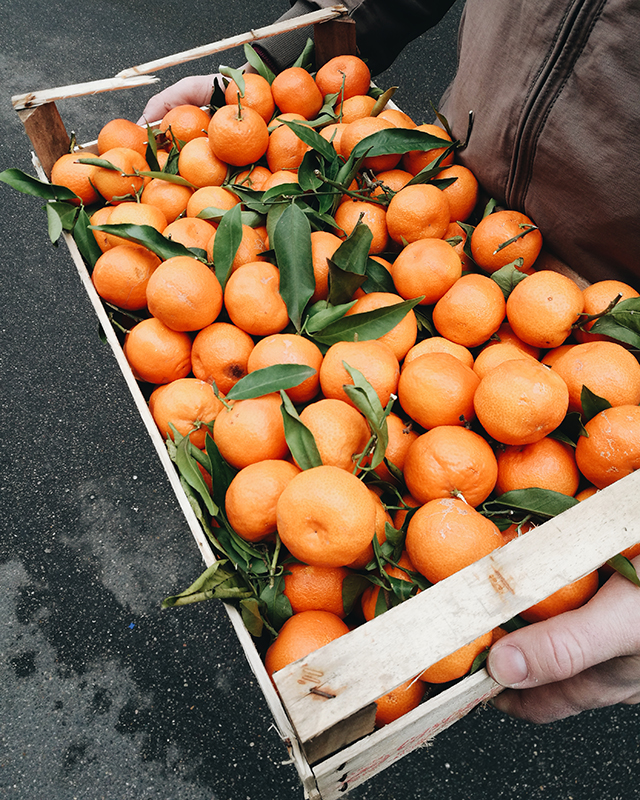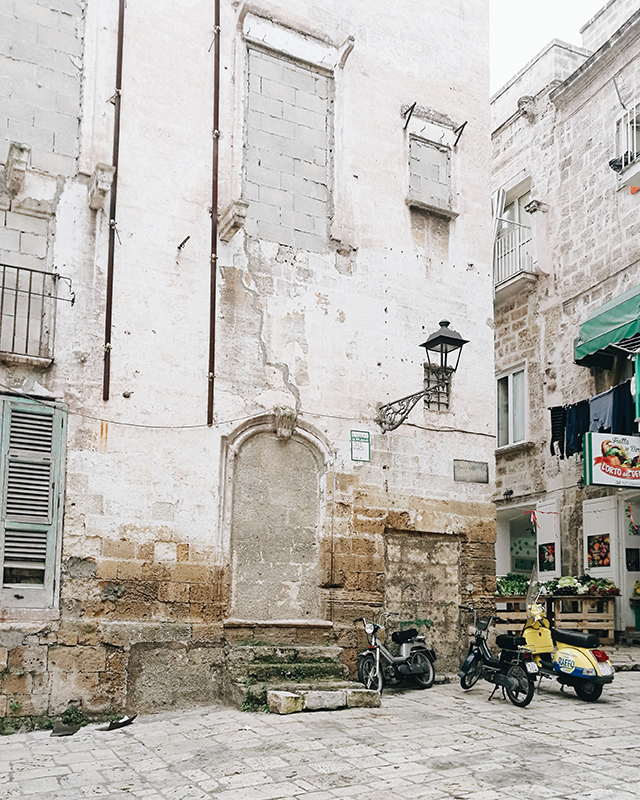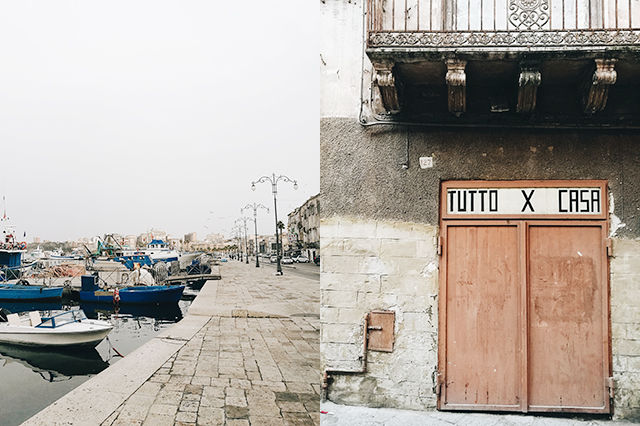
What would you do – you’re driving past hundreds of citrus trees. With a better look, they’re mandarins, or, more precisely clementines. On the roadside is a truck selling crates of them for 1 euro a kilo. You stop, right? And buy a crate of 10 kilos. Even though you have to get on a plane the next day.
I couldn’t help myself. Marco, who I had already made turn 180 degrees to drive back to the truck, gave me that look of disapproval when I want to do something totally unreasonable like impulse buy citrus fruit that we can’t keep. “What are we going to do with these?” He questioned. I wasn’t sure. I wanted to taste them, I wanted to photograph them. And maybe I could even squeeze some of them into our tiny bag to take home. “It won’t be a waste, I’ll give the rest away!” I reasoned.
He just shook his head, giving in. I bought them, a big grin on my face.


We were just outside the port city of Taranto, on the western coast of Puglia in Italy’s deep south, where we spent a long weekend recently and where clementines have special IGP (Protected Geographical Indication) status.
These clementines — a hybrid of oranges and mandarins — grow in the fertile soil around the gulf of Taranto, particularly around the town of Palagiano (also known as “the city of clementines” — they celebrate the symbol of their city with a sagra, a food festival, every December) and the delicate fruit is harvested by hand. We don’t get these in Florence, it was my only chance to taste them – they are small with very few, if any, seeds, and they are very sweet.
I did manage to bring a bag full of clementines home from our trip to Taranto – I probably had about 30 but had barely made a dent in my 10 kilogram crate. My intention was simply to gobble them up but one afternoon, my daughter suggested we make jelly. So I turned to Rachel Roddy’s new cookbook, Two Kitchens (if you are living under a rock and still need to catch up on her first cookbook, more here), where I spotted her Sicilian recipe for Mandarin jelly under her ‘Orange’ section in the Fruit chapter. The fruit is carefully carved out of its skin and the jelly set inside – just the thing I knew my 5 year old would love, a bit like a magic trick (or, as she said later, a prank, that she could play on unsuspecting diners).

The recipe is so simple there is really nothing to it. I used a lot less sugar because these clementines were like candy already, but if you have something more tart you will want to adjust to taste. The result is a lovely, refreshing and unexpected dessert – I think as adults we might even forget what the melt in the mouth texture of jelly is like, it’s just delightful. I wanted to keep taking spoonfuls. Harold McGee in On Food and Cooking explains, in his classic way, the science behind this joy:
“Jellies are remarkable in two ways. At their best they are translucent, glistening, beautiful on their own or as settings for the foods embedded in them. And the temperature at which the gelatin junctions are shaken apart is right around body temperture: so gelatin melts effortlessly in the mouth to a full-bodied fluid. They bathe the mouth in sauce. No other thickener has this quality.”

A note on gelatin. Here in Italy I use “colla di pesce”, which is sold in the form of gelatin leaves as opposed to powder and is derived from isinglass (fish). I recommend always double-checking by referring to the individual packet of gelatin that you have for liquid proportions because there may be some slight variation — according to Harold McGee, the standard is a 3% solution, or 7 grams for every cup (250 ml) of liquid, for the right kind of wobble you want in a dessert.
Clementine jelly inspired by Rachel Roddy’s gelatina di mandarini recipe in Two Kitchens: Family Recipes from Sicily and Rome (2017, Headline Home)
- 750 ml freshly squeezed clementine juice (about 12)
- 4 gelatin leaves
- 70-200 grams of sugar (to taste; Rachel calls for the latter but using very sweet fruit I only needed 70 grams)
If you’d like to serve the jelly inside the fruit shells, cut the tops of the clementines and pull out the segments carefully, keeping fruit in tact. Keep the shells in the fridge until needed.
Soak the gelatin leaves in a small bowl of cold water until softened (my daughter’s favourite part). Mix half of the juice with the sugar in a pan and warm over low heat until the sugar is dissolved. Add the drained gelatin, letting them dissolve one sheet at a time. Take pan off the heat, add the rest of the juice and stir. Pour the mixture into the empty fruit shells and leave to cool until room temperature then leave to set in the fridge — about 6 hours.
If using a jelly mould, simply grease with a delicate oil , pour the mixture in and refrigerate until set. When set, dip the bottom quickly into a bowl of hot water to loosen (don’t leave it too long, it melts!) then invert onto a plate.




Comments
What a delightfully light dessert and gluten free, win, win, thanks.
Wow I had no idea that Palagiano was the city of clementines, kind of gives me a bit of motivation to pay this region a visit come December. I love the sound of the recipe too, I’m looking for more dessert options with less sugar!
I love the story of your husband turning the car around for you 🙂 Will have to try this recipe when mandarins are in season here! Not long now, it actually feels like autumn today even after a 32C day on Sunday. This weather is nuts!
When someone does that for you and knows that you’re nuts, he’s a keeper! 🙂